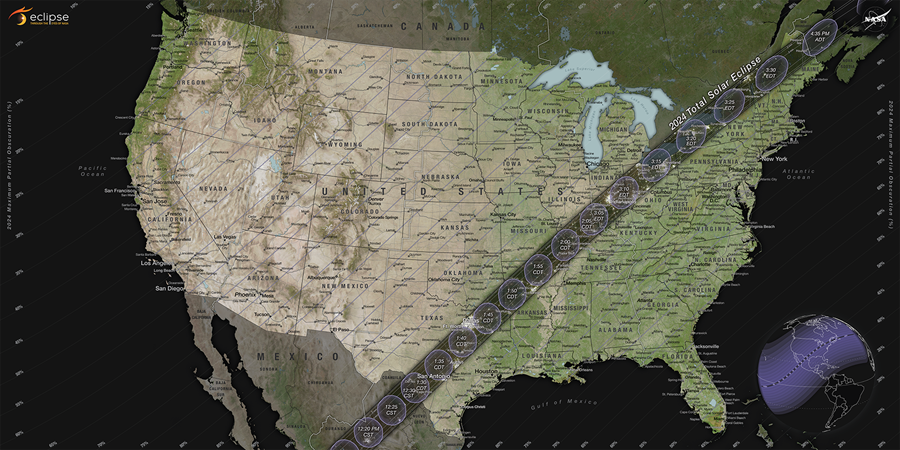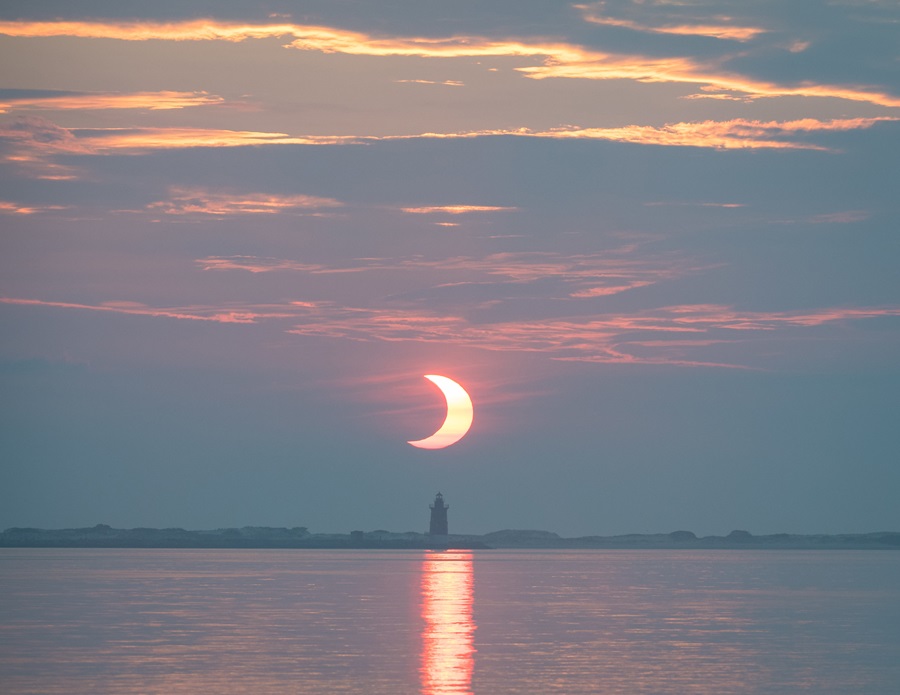The solar eclipse on April 8 is America’s headline astronomical event of 2024, but Cape Cod isn’t in the path of totality. That means we won’t experience the otherworldly twilight of a total eclipse — but a 90-percent solar eclipse is still a magical experience.
People have felt wonder when experiencing eclipses since our oldest recorded histories. They may seem portentous, but they happen due to chance. The Moon is about 2,100 miles in diameter while the Sun’s diameter measures over 850,000 miles. But the Sun is 93 million miles away, while the Moon is only 220,000 miles distant. By the most wonderful of celestial coincidences, that big difference in distance means that the two objects appear almost the same size from our point of view. So, when the Moon crosses in front of the Sun, as it will on April 8, it will completely block the Sun, casting a shadow on Earth’s surface — that’s a total solar eclipse.
That shadow will fall over a swath of Earth that’s only about 100 miles wide, and its effect will last for only a few hours, until the alignment of Sun and Moon ends. During that time the shadow moves fast — over 1,000 miles per hour. The three or four minutes it takes for the shadow to pass over an observer on Earth is called totality.

You’ve probably seen photos of totality. They often show how the Sun is covered while the corona, its atmosphere of glowing plasma filaments, becomes visible. During totality, day turns into an eerie twilight; the wind increases; the temperature drops; animals react strangely. Creatures that are active during the day may switch to their nighttime behaviors, while nocturnal animals may stir.
Humans react, too. I’ve never experienced a total solar eclipse. But people describe exultation, quiet awe, and being moved to inexplicable tears by the surreal beauty of those strange few minutes. Among amateur astronomers, there is a subset of eclipse chasers; these are enthusiasts who travel the world to experience eclipses whenever and wherever they can.
A total solar eclipse occurs somewhere on Earth once every year or two. But there are other not-quite-total solar eclipses that also occur. Annular eclipses are when the Moon passes directly in front of the Sun but appears slightly smaller than it, leaving a bright ring (or annulus) around its edges.
The Moon’s distance from Earth varies slightly; it’s sometimes closer (making it appear larger) and sometimes farther away (making it appear smaller). When the Moon is at its maximum distance from the Sun and passes in front of it, we get an annular eclipse.
A partial eclipse is when the Moon and Sun don’t quite line up, and only part of the Sun is obscured. This happens because of variations in the Earth’s and Moon’s orbits. But it is also seen during a total solar eclipse when the observer is outside that narrow path of totality. And this is what people on Cape Cod will experience on April 8.

Here’s how totality will miss us: On Monday, April 8 the Moon’s shadow will make landfall on the west coast of Mexico and race northeast. It will track through Texas and Arkansas, through several Midwestern states, northern New York and New England, and on into Canada and the Atlantic. It will miss Massachusetts.
The farther you are from totality, that 115-mile-wide swath of shadow, the less dramatic the eclipse will appear. We will be just outside totality, so we will experience a 90-percent eclipse, meaning that 90 percent of the Sun will be covered at eclipse maximum.
On April 8 at 2:17 p.m., the dark shadow of the Moon will contact the solar disk. You won’t notice anything at first. But over the next hour, the Sun’s light will grow dimmer and the colors around you cooler. The temperature may drop by some 10 degrees. The wind may pick up and shift directions.
Look down at the shadows on the ground. They will become sharper. Even more bizarre, look for the shadows of leaves. They’ll appear crescent shaped. What you’ll see are not shadows but images of the partially eclipsed crescent sun projected onto the ground. This optical phenomenon is caused by the small gaps between leaves acting as pinhole cameras.
Eclipse maximum will be at 3:30 p.m. Only a thin sliver of the Sun’s disk will remain uncovered, but it will still be fiercely bright. Although it may seem as if you could, do not look at the eclipse! You’ll damage your eyes.
Maximum lasts for a few minutes, then the process will reverse over another hour. Light, color, and warmth will slowly return; shadows will resume their natural forms; the Sun will still shine. But the experience will stay with you.
I can’t imagine what it would be like to see the effects of a solar eclipse without any scientific understanding of what’s happening. It would be terrifying. The few times I’ve witnessed partial eclipses I’ve felt a little thrill of fear. Feeling the Sun weaken over a few minutes’ time rather than over the weeks and months of autumn affected me on a visceral level. Let’s hope for clear skies on April 8!
Safety warning: Do not look directly at the Sun during an eclipse or use binoculars or telescopes (unless equipped with solar filters). You’ll permanently damage your eyes. Use only eclipse glasses with ISO certification. I’ve heard reports of fake eclipse glasses being sold. If you have any doubt about yours, do not count on them protecting you.



